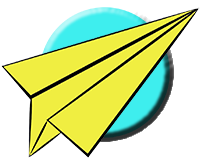Fast Bottlenose Paper Airplane Instructions
Fast Bottlenose Paper Airplane Instructions
Instructions
This interesting looking square craft works best with light to medium weight paper. Start with a letter size sheet.
1. Start with a letter size sheet. Fold the paper exactly in half along its long edge. Unfold after the crease has been made.
2. Fold the top edge of the paper over so the edge hits the center line crease.
3. Fold the bottom edge of the paper up so the edge hits the center line crease.
4. Fold the upper left corner down so the upper left point hits the center line crease. When folded correctly, the left half of the top edge should line up with the center line crease.
5. Fold the upper right corner down so the upper right point hits the center line crease. When folded correctly, the right half of the top edge should line up the center line crease.
6. Unfold both of the corner flaps just created.
7. Fold the top edge down making a new crease. When folded correctly, this new horizontal crease should line up with the points on the left and right edges of the paper formed by the existing diagonal creases.
8. Make a crease for the left wing flap. The top point of the crease should be at the point of the center line formed by the horizontal crease. The bottom point should be at the lower left hand corner.
9. Make a crease for the right wing flap. The top point of the crease should be at the point on the center line formed by the horizontal crease. The bottom point should be at the lower right hand corner.
10. Fold the upper left corner down so the upper left point hits the center line crease. When folded correctly, the left half of the top edge should line up with the center line crease.
11. Fold the upper right corner down so the upper right point hits the center line crease. When folded correctly, the right half of the top edge should line up with the center line crease.
12. Fold the point on the left edge of the nose over so it hits the center line crease. When folded correctly, the upper left diagonal edge should line up with the center line crease.
13. Fold the point on the right edge of the nose over so it hits the center line crease. When folded correctly, the upper right diagonal edge should line up with the center line crease. Be sure to line up up the folds for good balance.
14. Flip the plane over, keeping the nose at the left.
15. Fold the plane in half about the existing center line crease.
16. Flip the plane over again with the nose to the left and the wing flaps up.
17. Make a crease for the tail section. The right point of the crease should be about two finger widths up from the base and the left point should be not quite half way along the bottom edge of the fuselage.
18. Unfold the tail section crease.
19. Flip the plane over and rotate it around so the nose is up and the wing flaps are to the left.
20. Unfold the plane about about the center line crease.
21. Fold the plane in half again tucking the tail section up and into the body. When folded correctly, the tail section should be between the main body and hidden from view.
22. Flip the plane over yet again with nose to the left and the wing flaps.
23. Make a crease for the first wing flap. The right point of the crease should be at the bottom of the edge and the left point should be about one finger width up from the base. The crease should be even with the bottom edge of the fuselage.
24. Fold the tip of the lower wing flap up about the existing crease.
25. Flip the plane over so the first wing flap is underneath and the nose points to the left.
26. Make a crease for the second wing flap. Be sure to line up the wing flaps for good balance.
27. Fold the upper wing tip down about the existing crease.
28. Open the wing flaps and adjust the wing angles so they are even. Make sure that the main wing flaps have a good measure of down dihedral angle while keeping the wing tips up.
THE THROW: Launch this craft with a swift throw at just about any angle you wish. If it spirals through the air, make sure the nose is perfectly straight, the dihedral angle is definitely downward, and the wing tips are even. This one travels fast so be careful.
